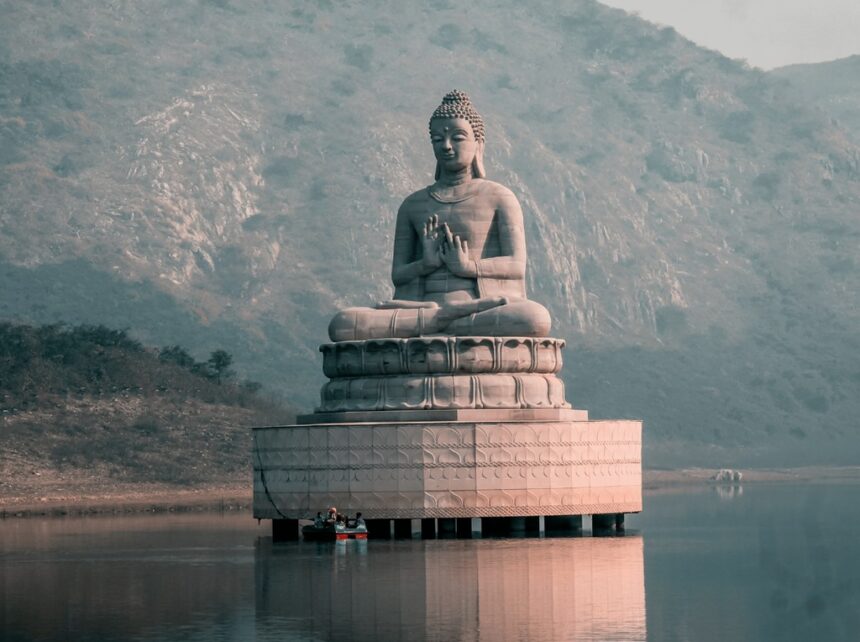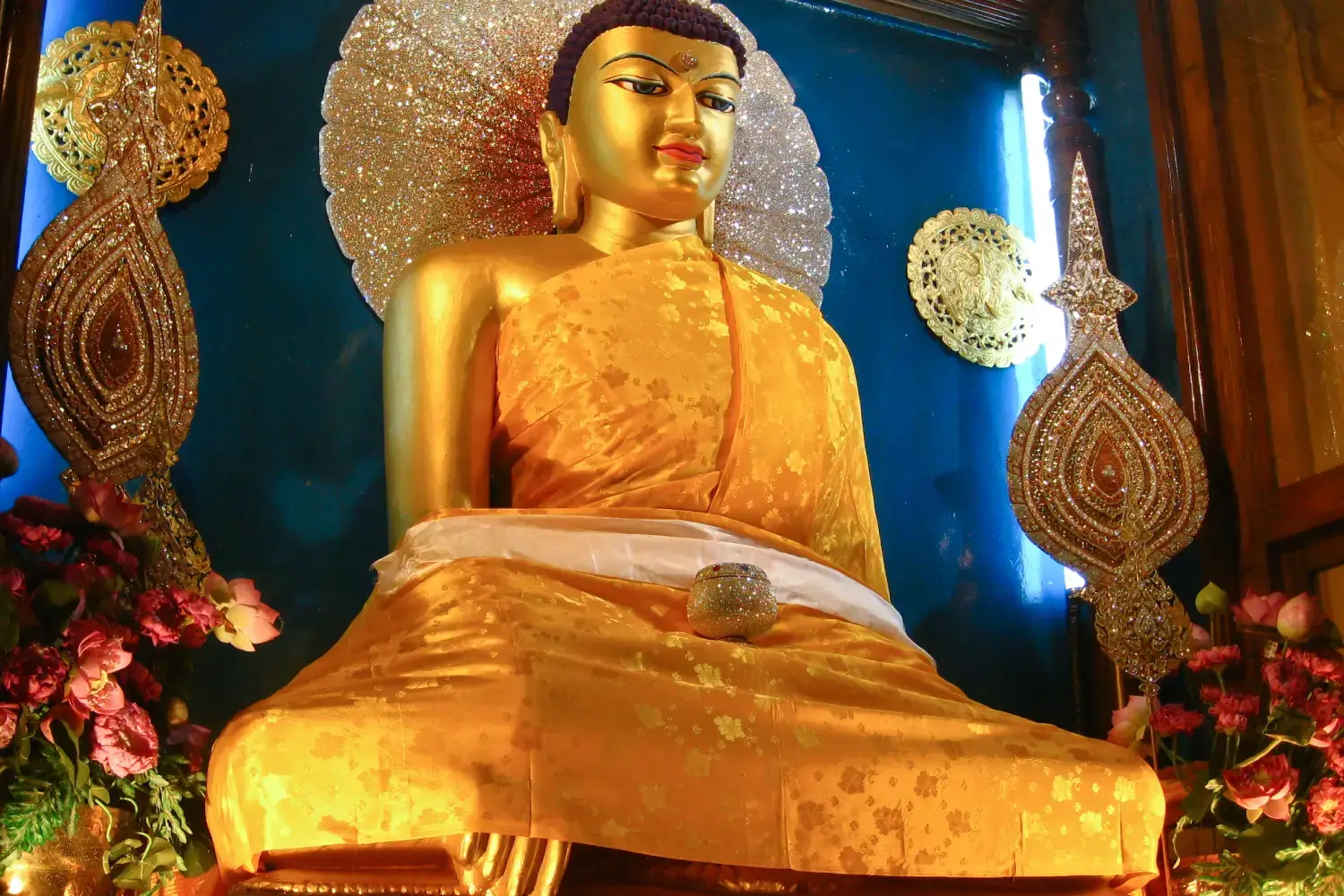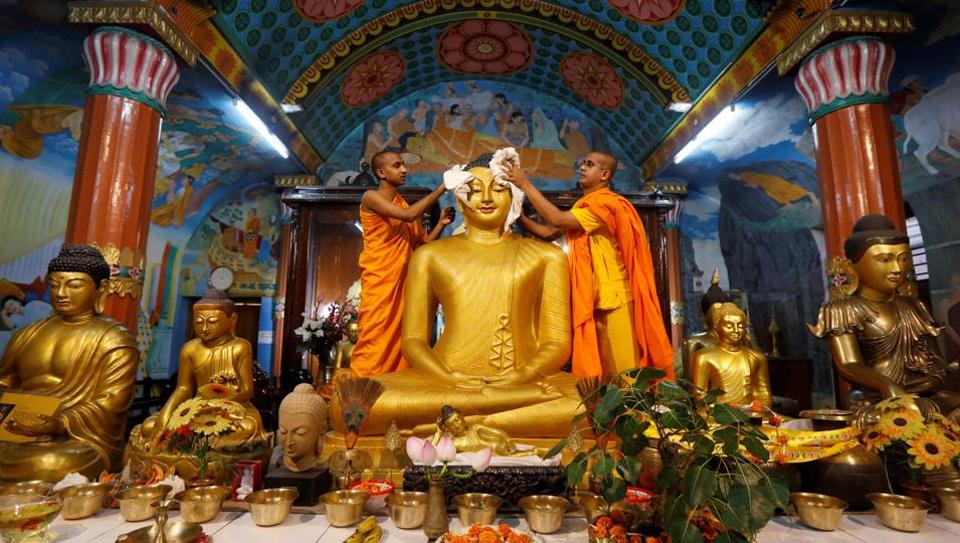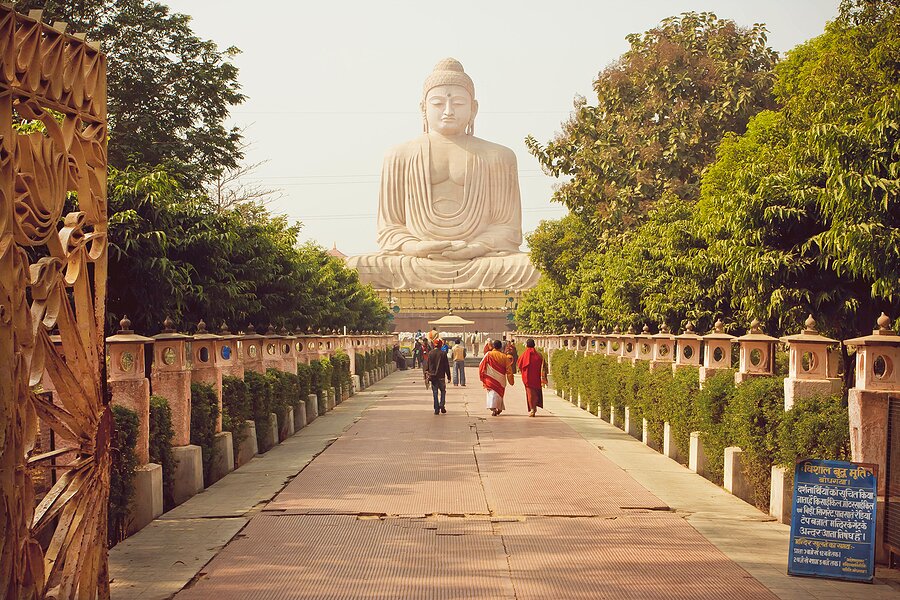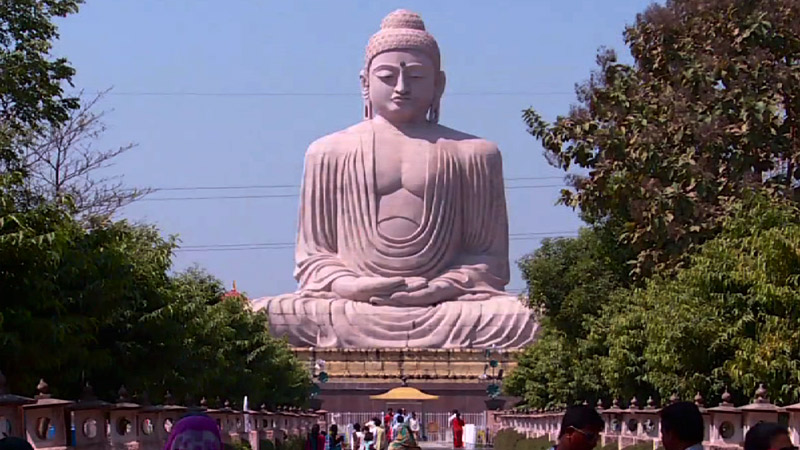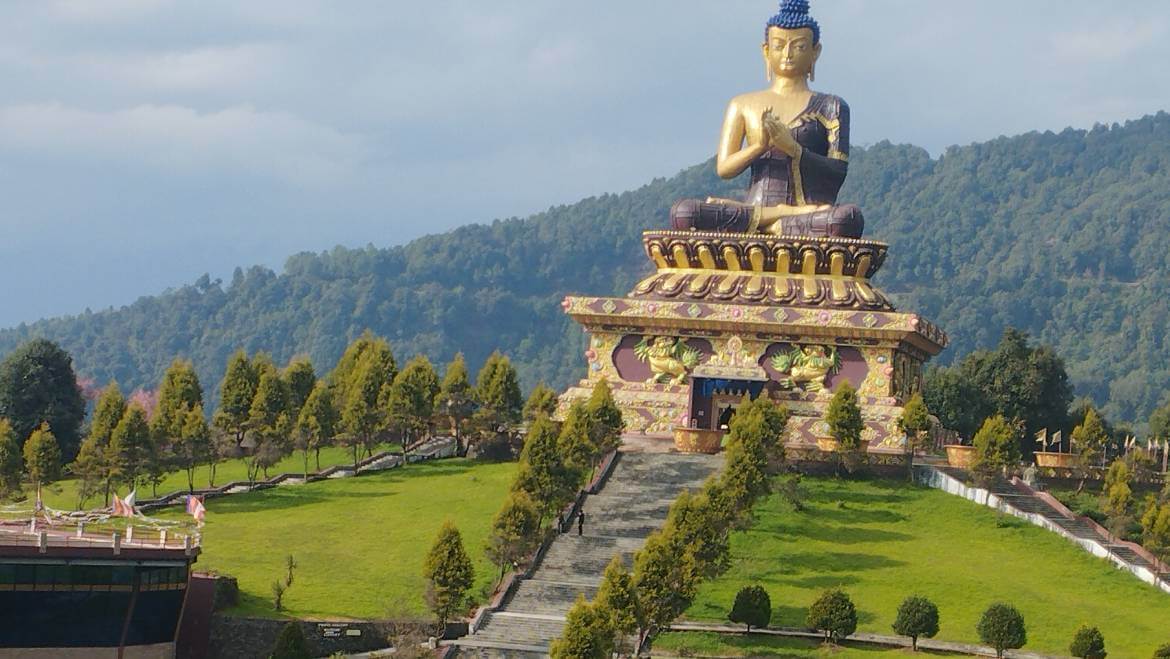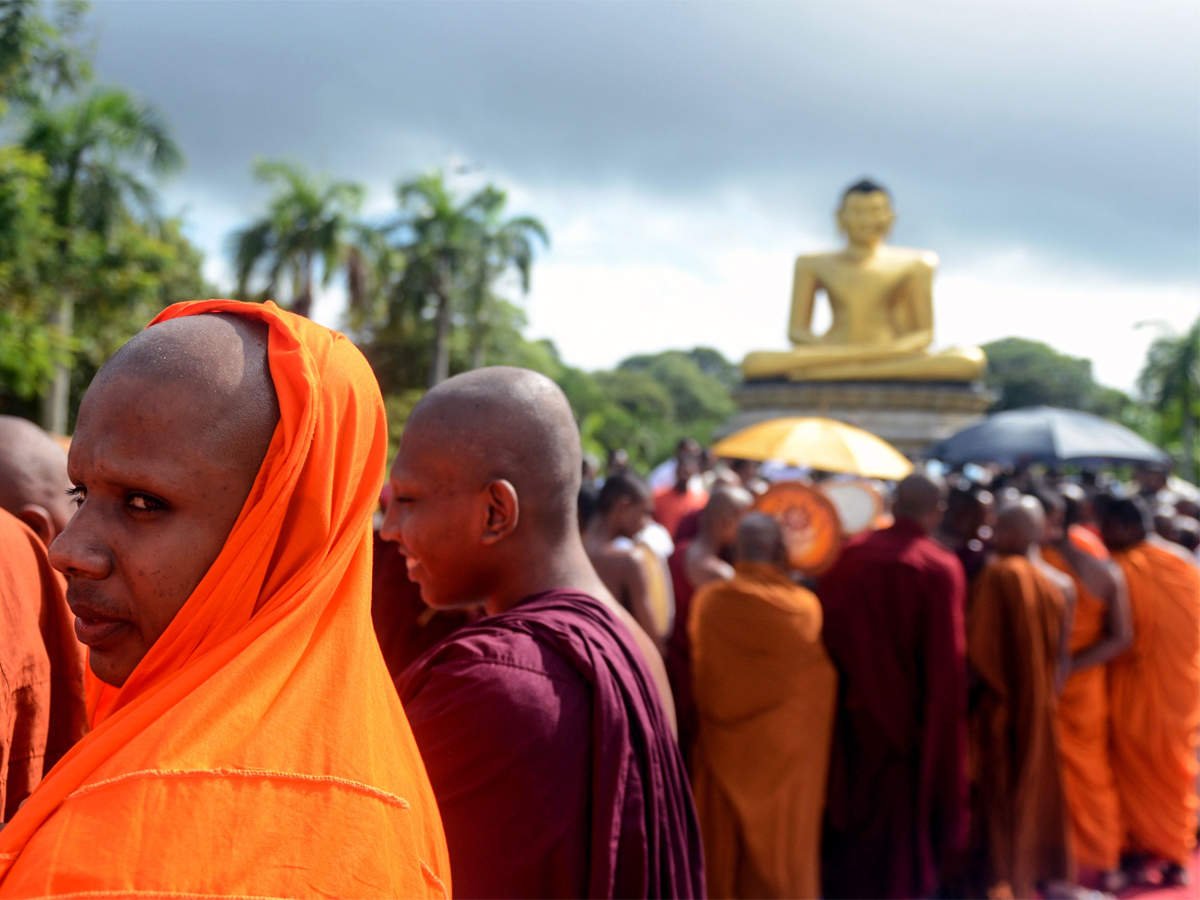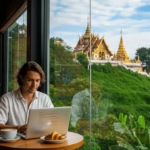Picture the calm face of a Buddha statue, eyes lowered, hands at rest. That serene image has deep roots in Buddhism, where statues symbolize peace, compassion, and the possibility of awakening. A Buddha statue is not just art; it is a reminder to breathe, stay present, and choose kindness.
The story begins with Siddhartha Gautama, born in northern India in the 6th to 5th century BCE. He left a life of comfort, searched for an end to suffering, and found enlightenment under the Bodhi tree. His simple teachings on the Four Noble Truths and the Eightfold Path spread across India through monks, monasteries, and royal support.
Early Buddhists did not show the Buddha in human form. They used symbols instead, like the Bodhi tree, a wheel, a footprint, or an empty throne. These signs pointed to his presence and teaching, without showing his body.
Over time, artists began to shape the Buddha in human likeness. This shift took hold around the 1st to 2nd century CE in centres like Mathura in India and Gandhara to the northwest. The styles varied, but the message stayed the same: inner stillness, ethical living, and insight.
This post walks through the change from symbols to sacred icons in India. You will see how faith, art, and history met to create the images we know today. By the end, the next Buddha statue you see might feel a little more alive, and a little closer to home.
The Foundations of Buddhism in India
Buddhism took shape in northern India through real places, lived choices, and a simple path anyone could follow. Before the first carved images appeared, the faith grew through stories, symbols, stupas, and monastic communities. This groundwork set the stage for the Buddha Statue to emerge later as a focus for devotion and teaching.
Siddhartha Gautama’s Journey to Becoming the Buddha
Siddhartha Gautama was born in Lumbini to a royal Shakya family. Early comfort could not shield him from the sight of sickness, old age, and death. Those moments pushed him to leave palace life and search for a way out of suffering.
He tried severe fasting and hardship, then turned to the Middle Way, a balanced path. In Bodh Gaya, seated under the Bodhi tree, he faced Mara, the personification of fear and temptation. He stayed steady, saw reality clearly, and awakened to nirvana around the 5th century BCE.
Soon after, he taught at the Deer Park in Sarnath, sharing the Four Noble Truths and the Eightfold Path. With that first sermon, he set the Sangha in motion. For early followers, his presence was honoured through symbols, not portraits. The Bodhi tree, a wheel, footprints, or an empty throne stood in for his body, keeping attention on the teaching rather than a face.
Key moments often shown in early art:
- Birth at Lumbini: A gentle start to a life of teaching and compassion.
- Renunciation: A clean break from privilege to seek truth.
- Enlightenment at Bodh Gaya: Calm strength in the face of Mara.
- First sermon at Sarnath: The Dharma set in motion.
This symbolic habit shaped early Buddhist spaces. It also left room for images to grow later, when communities sought a human focus for devotion and memory.
The Spread of Buddhist Teachings Across the Subcontinent
In the 3rd century BCE, Emperor Ashoka accepted the Dharma after the Kalinga war. He backed monasteries, protected the Sangha, and sent missions across India and beyond. His pillars and rock edicts promoted ethics, compassion, and non‑violence. Stupas rose as reliquary mounds and teaching hubs, while monks travelled, taught, and copied texts.
Sites like Sanchi and Bharhut show how early Buddhist art spoke in signs. Reliefs on gateways and railings featured:
- Stupas framed by worshippers, highlighting veneration and pilgrimage.
- The Dharmachakra (wheel), marking teaching and right action.
- Empty thrones and footprints, signalling presence without a portrait.
- Jataka tales, showing the Buddha’s past lives as moral examples.
As communities widened, practice shifted. Mahayana currents encouraged lay devotion, compassion for all beings, and a closer bond with enlightened figures. Pilgrims wanted a focus for prayer and meditation. Human images began to answer that need, turning teachings into a face to remember and emulate.
Before statues, stupas, and monasteries carried the faith:
- Stupas: Centres of pilgrimage, ritual, and storytelling through carved panels.
- Monasteries: Places for study, debate, and daily practice that kept the Dharma alive.
This mix of royal support, sacred sites, and growing devotion prepared the ground for the Buddha Statue. When artists later shaped the Buddha in human form, they were building on centuries of memory, movement, and meaning already in place.
How Buddha Statues Emerged from Symbols to Sacred Icons
Before the first Buddha Statue appeared, early Buddhists spoke through signs. Artists kept attention on the Dharma, not a face. They pointed to the presence without a portrait, honouring teachings on impermanence and avoiding idol worship. By the 1st to 2nd century CE, devotion and pilgrimage created a need for a human focus. Images took on a body in regions like Mathura and Gandhara, and the Buddha Statue began its rise as a sacred icon.
Early Symbolic Representations in Buddhist Art
At sites like Bharhut and Sanchi, the Buddha appears without a body. Sculpture panels on railings and gateways show scenes you can read like a story, yet the teacher is absent in form. Symbols stand in for his presence and message.
Common symbols and what they meant:
- Bodhi tree: The place of awakening at Bodh Gaya. Artists carved the tree to signal enlightenment without carving the enlightened one.
- Dharma wheel (Dharmachakra): The first turning at Sarnath, and the path of right action. A wheel on a pedestal marks teaching in motion.
- Stupas: Reliquary mounds that hold memory, story, and sacred power. Panels show worshippers circling a stupa, signalling pilgrimage and veneration.
- Empty throne: Presence without a person. The throne says, the Buddha is here in truth and teaching.
- Footprints: Human touch without a portrait. They speak to the journey, the earth, and the path walked.
Why early art avoided human form:
- Respect for impermanence: A fixed image risks clinging. Symbols kept focus on practice, not the body.
- Guarding against idol worship: Early communities prized the teaching over likeness. Symbols acted as reminders, not objects of attachment.
- Clarity for pilgrims: Simple signs travelled well and taught fast. A wheel or tree told the story at a glance.
This symbolic habit held for centuries around core sites like Bharhut and Sanchi. Then, as devotion grew, communities asked for a form they could greet, circumambulate, and remember. Around the 1st to 2nd century CE, anthropomorphic images appeared in regional centres. The shift did not reject symbols. It added a human presence that met the needs of worship, teaching, and community life. From that point, the Buddha Statue stood alongside the Bodhi tree and Dharma wheel as a shared language of faith.
Exploring Iconic Styles of the Buddha Statue in India
When images of the Buddha took human form in India, two style centres led the way. Mathura shaped a warm, native face for devotion. Gandhara brought a classical touch from the northwest. Together, they set the visual language that still guides how a Buddha Statue looks and feels.
Here is a quick snapshot before we look closer.
| School | Material | Key features | Centres | Date |
|---|---|---|---|---|
| Mathura | Red sandstone (often white‑spotted) | Robust body, broad chest, soft smile, thin robe, yaksha feel | Mathura (Uttar Pradesh) | 1st century CE onward |
| Gandhara | Grey schist, stucco | Deep drapery folds, wavy hair, realistic face, classical calm | Taxila, Peshawar, Swat, Hadda | 1st to 2nd century CE |
The Indigenous Mathura School of Sculpture
The Mathura school grew in Uttar Pradesh and carved a confident, rooted Indian image of the Buddha. Artists used local red sandstone, often with tiny white specks that catch the light. The body looks strong and present, with a broad chest, sturdy legs, and a gentle, close‑fitting robe that hints at the form beneath.
This look drew on older yaksha figures, large guardian spirits known for power and abundance. You can feel that energy in early Mathura pieces, where the Buddha stands tall, feet planted, and eyes calm. The style reads as warm and human, not distant.
What to watch for in a Mathura Buddha statue:
- Material: Red sandstone from the region, sometimes white‑spotted.
- Form: Rounded cheeks, strong torso, soft belly, subtle smile.
- Dress: A thin robe that clings lightly, with simple folds.
- Markers: Usnisha (cranial bump), urna (hair whorl), wheel marks on the soles.
By the 1st century CE, the style was mature. Early dated examples and inscriptions mark a thriving workshop tradition. Museums in Mathura display striking pieces from this phase, showing the Buddha seated or standing with a right‑hand gesture of reassurance. The overall mood is earthy and direct, an Indian aesthetic that speaks of presence and grace.
The Greco-Buddhist Gandhara Influence
Far to the northwest, along trade routes in modern Pakistan and Afghanistan, Gandhara artists shaped the Buddha with a classical touch. They were carved in hard grey schist and cast or modelled in stucco. The result is crisp detail: deep, rhythmic folds in the robe, wavy hair, and an even, realistic face.
This look came from contact with Hellenistic art after Alexander and later Indo‑Greek and Kushan ties. At sites like Taxila and in valleys across Swat and Peshawar, workshops fused Buddhist themes with classical skills. The robe falls like a Roman toga. The hair has gentle waves. The body is lean and proportioned with care.
Key traits of Gandhara Buddha statues:
- Drapery: Heavy, layered folds that frame the body.
- Head and hair: Wavy locks, often a topknot, clear facial modelling.
- Material: Grey schist for sharp carving, stucco for expressive faces.
- Mood: Calm majesty with lifelike detail.
Kushan rulers, including Kanishka, backed monasteries and artists in the 1st to 2nd century CE. Their support helped this fusion thrive. Gandhara gave the Buddha a classical poise without losing spiritual depth. It offered a face of teaching, still and compassionate, fit for pilgrims moving along the Silk Routes.
The Meaningful Reclining Buddha Statue
The reclining pose shows the Buddha in Parinirvana, his final passing at Kushinagar. He lies on his right side, head propped on the right hand, body at rest, face at peace. The message is clear: release from suffering, calm acceptance, and the end of the cycle of rebirth.
Art historians trace early versions to Gandhara workshops between about 50 BCE and 75 CE, where narrative skill and realistic bodies made the scene vivid. In India, large reclining figures are less common than in Thailand or Myanmar, but they carry a strong presence when they appear. A famous example stands in Kushinagar at the Mahaparinirvana Temple, where a long sandstone image draws quiet crowds.
How to read a reclining Buddha statue:
- Pose: Right side, head on hand, feet neatly aligned.
- Expression: Gentle smile or soft, calm eyes at rest.
- Meaning: Final release, compassion carried to the end.
- Rarity: Less frequent in India, widespread in Southeast Asia.
Together, Mathura, Gandhara, and the Parinirvana image show how the Buddha statue took shape in India. One style speaks of earth and presence, one of classical grace, and one of peaceful release. Each invites a different way to meet the same teaching.
Conclusion
From early symbols to the first carved faces in Mathura and Gandhara, the Buddha statue carries a clear promise: peace is possible in daily life. These images still guide meditation, steady the breath, and invite kind action. In monasteries, museums, and living temples, a Buddha Statue helps people centre their minds and return to the Eightfold Path.
Across India, cultural heritage sites keep that spirit alive and accessible. Bodh Gaya hums with quiet focus. Sarnath, Sanchi, and Ajanta map the spread of the Dharma in stone. Kushinagar, with its reclining image, reminds us that release from suffering is the goal. Each site draws travellers, artists, and seekers who want both culture and calm. Tourism supports preservation, and in turn, preservation deepens practice.
Let the next Buddha statue you meet become a moment to pause. If you can, visit Bodh Gaya, Sarnath, Sanchi, Mathura, or Kushinagar, and sit for a few minutes in silence. If you are at home, set a simple space, breathe, and reflect on compassion. The heart of Buddhism is steady and simple: peace for yourself and for others. Thanks for reading, and feel free to share where a Buddha Statue has inspired you.




